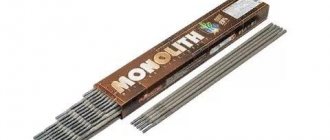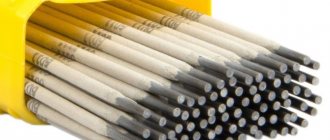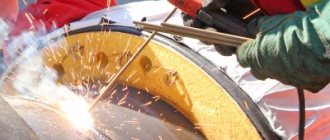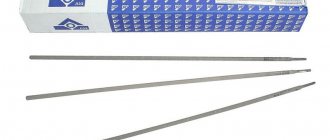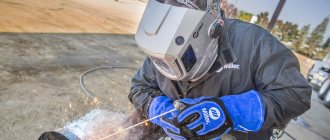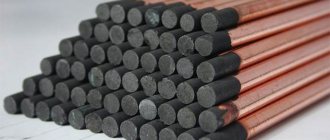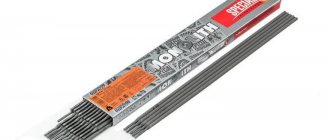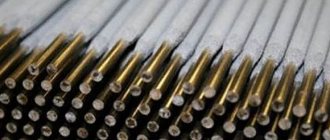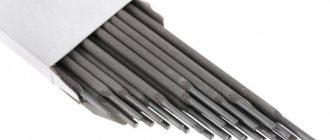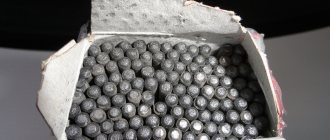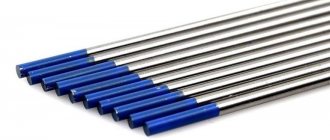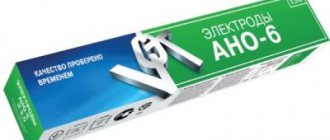Description and explanation of the abbreviation
The electrodes form an even, smooth seam and maintain a stable electric arc. Special technical characteristics make it possible to comply with the requirements for welded joints at any production facilities. The elements are used for welding workpieces made of low-carbon steel with a minimum content of alloying additives. With a uniform supply of current, long-lasting, high-strength seams are formed with the help of “LB 52U” elements.
Manufacturers offer 4 product options - with diameters of 2.6, 3.2, 4 and 5 mm. The name of the consumable includes an abbreviation, the decoding of which helps to select an element suitable for performing the assigned tasks.
The meanings of the symbols and numbers will be as follows:
- L – rod length;
- B – type of coating;
- U – application for welding low-carbon steel workpieces;
- 53 is a factory code that has no technical value.
Specifications
“LB 52U” products are used in the formation of complex metal structures.
The electrodes have the following technical characteristics:
- Material of manufacture – low carbon steel. This chemical composition allows you to obtain a strong weld that has no flaws.
- Field of application: electric arc welding. Other technologies do not use such products.
- Box weight – 5 kg.
- Type of operating current – direct, alternating.
- The highest fluidity is 530 MPa.
Characteristics of LB electrodes
Japanese welding components are available in four diameters. Depending on this value, the length of the rod itself changes, as well as the current required for operation:
- Ø 2.6 mm - electrode length 350 mm - current strength from 60 to 90 A;
- Ø 3.2 mm - 400 mm - from 90 to 130 A;
- Ø 4.0 mm - 400 mm - from 130 to 180 A;
- Ø 5.0 mm - 400 mm - from 180 to 240 A.
However, despite the differences, each product has certain characteristics:
- Electrode brand: LB 52u.
- The weight of the finished package is 5 kg.
- The type of current used is direct and alternating.
- Maximum fluidity - 530 MPa.
- Tensile strength - 588 MPa.
- The open circuit voltage value is B.
- Welding attributes classification - E7016-1/AWS A5.1.
As a rule, after completion of work, no more than:
- 0.005% sulfur;
- 1% manganese;
- 0.06% carbon;
- 0.51% silicon.
Composition of electrodes LB 52U
Branded products are characterized by good performance qualities associated with the chemical properties of the substances included in their composition.
Kobelco LB 52U electrodes contain the following components:
- The base is low-carbon steel, which maintains a stable electric arc.
- The weld metal is a mixture of nickel, molybdenum, silicon and some other strong substances.
All components are introduced into the electrode in strictly prescribed quantities, which ensures high performance.
GOST compliance
When producing consumables for welding machines, compliance with state standards is taken into account.
We recommend reading Technical characteristics of MP-3 electrodes
GOST prescribes the following quality assessment criteria:
- rod diameters;
- stability of the formed arc;
- concentration of toxic substances in the composition.
LB520U electrodes have passed mandatory certification. This means that they comply with state standards GOST 9467-75, 9466-75.
LB 52U electrodes are useful for arc welding of pipes, tanks, and structures.
Let's compare
A whole galaxy of specialized Japanese rod electrodes with external coating from Kobe has appeared, included in the FAMILIARC group of materials with a guarantee of tensile strength of the seam within 590 MPa.
These are LB 62D, LB 62U, LB 106. The alphanumeric abbreviation stands for:
- L – coated electrode for arc welding;
- B – coating of the basic (alkaline) type;
- 52 – internal serial designation of development;
- U – specific application: carbon and low-carbon steels with low alloying.
LB-52U electrodes are positioned as specialized low-hydrogen electrodes for performing root welds without the need for back welding . The integrity of the connection and the uniformity of load absorption ensure the unity of the material of the root, filling and facial seams.
The key difference of the FAMILIARC group is the priority of a one-sided seam with reinforcement on the wrong side. The root scaly roller with a penetration depth of the full size of the cutting bluntness is not available to domestic UONI 13/45, MTG-01k, MTG-02. Of the imported analogues, the Japanese Nittetsu S-16W and OK 53.70 ESAB demonstrate similar properties.
Kobelko electrodes demonstrate arc stability, uniform penetration of seamless pipe steels of strength classes K54–56 (alloys 13G2AF, 09GBF, 13G1S-U, 17G2SF, 12G2SB) without the use of lining materials.
The inner surface of the seam is reinforced . Lack of penetration and undercuts are excluded if the technological requirements for the magnitude of the current load on the thickness of the rod and the speed of passage of the section are observed. The mode of strengthening the base of the seam during one-sided welding is given the term uranami.
Single-sided welding performed with Kobelko LB-52U low-hydrogen electrodes is free of technical defects that require partial restoration of the cutting and re-welding:
- Pore formation;
- Microcracks in the weld body and interfaces with solid metal;
- Shells and caverns.
Duration of operation while maintaining characteristics of resistance to dynamic loads became the basis for NAKS certification and VNIIST recommendations for use in the repair and construction of high-pressure main pipelines.
The design pressure for low-alloy straight-seam and solid-rolled gas and oil pipelines made of steel 10G2FBYu (K60) is 10 MPa. Bridge structures can withstand no less loads at constant voltage.
Scope of application of electrodes
The chemical properties of the consumable material provide increased impact strength.
Therefore, electrodes are often used in the following cases:
- formation of large-volume tanks for storing petroleum products, drinking water and other liquids;
- connection of steel pipeline elements;
- assembly of structures used in automobile and shipbuilding.
When determining the scope of application of low-carbon steel electrodes, the following recommendations are taken into account:
- Rods with a diameter of 2.6 mm are used in the formation of the main layers of a welded joint and cladding of metal structures. This protects welds from the influence of negative atmospheric factors and aggressive substances.
- Electrodes measuring 3.2 and 4 mm are also used in the above situations. In addition, they are used for welding defects.
The scope of use of products is wide, but they are rarely used in the manufacture of load-bearing structures subject to increased loads.
Product Features
LB-52U electrodes for welding are produced by the Japanese company Kobelco. Most often, such products are used for welding steel parts. Thanks to their properties, they perfectly create seams in any conditions.
They are divided into 4 varieties depending on thickness. In addition, the technical characteristics of LB-52U electrodes differ in length and specific current strength, namely:
- The thinnest has a diameter of 2.6 mm. Its length is 35 cm, and the current required for operation is about 75 A.
- The thicker variety has a diameter of 3.2 mm and a length of 40 cm. The current required for welding is about 110 A.
- The welding components are 4 mm in diameter and 40 cm long. They require a current of about 150 A.
- The thickest ones are 5 mm thick and 40 cm long. To operate, they require the highest current strength - about 200 A.
General recommendations
Compliance with the following rules helps to increase the strength of welded joints:
- It is not recommended to work with wet electrodes. Before welding, the rods are dried for 40-60 minutes.
- The welding process begins by supplying the minimum current required to calcinate the consumable material. During operation, the parameter is increased gradually.
- An aesthetically pleasing, even connection is obtained by choosing the correct groove shape and electric arc temperature. To select values, inexperienced welders use special tables.
LB 52U electrodes are considered one of the best surfacing electrodes.
Characteristics, advantages and disadvantages
Despite the fact that there are clear differences between all of the above varieties, they have a lot in common . In particular, they all have the same brand, namely “lLB-52U” ; total package weight - 5 kg; maximum strength - 588 MPa; the highest fluidity is 530 MPa.
These electrodes can operate using direct or alternating current . At the end of the work, the electrode typically contains less than 1% manganese, less than 0.5% silicon, less than 0.05% carbon and less than 0.005% sulfur.
Thanks to its positive properties, the characteristics of LB-52U electrodes are confirmed by many advantages:
- They are economical.
- Provides excellent seam connection.
- They contain little hydrogen.
- They have excellent resistance to mechanical stress.
- Only a small amount of metal particles splashes during operation.
- The slag crust comes off very easily.
- With their help, metal can be melted to great depths.
- The finished connection has good ductility.
- The seams formed during welding have a pleasant appearance.
- They provide good impact strength.
Proper storage
The attached instructions indicate the rules for transporting and storing the product.
Important conditions are:
- Humidity. Increasing this parameter negatively affects the performance characteristics of the rods. If stored improperly, the rods become damp and become unsuitable for their intended use. At +5-15 °C air humidity should not exceed 60%. For 15-25 °C this value is 50%.
- Temperature changes. Products are placed in a dry heated room. Due to sensitivity to high humidity, electrodes cannot be stored outdoors.
We recommend reading Features and important nuances in the use of TsCh4 type electrodes
Elements must not be exposed to ultraviolet radiation. If the recommendations are followed, the rods will be suitable for use throughout their shelf life. Otherwise, the finished welded joint will contain voids, cracks and other defects.
Electrode manufacturers
The products produced by the following companies are considered the best:
- Lincoln Electric. The products are affordable, making them the best choice for beginners. They easily form an electric arc, maintaining it in a stable state throughout the welding process. The products are compatible with most types of devices. It is not necessary to control the arc length; the electrodes are resistant to its change. The use of Lincoln Electric products reduces the risk of fire due to the minimal amount of flying sparks. The resulting seam is aesthetically pleasing and durable.
- ESAB-SVEL. The products operate normally under alternating and direct current. The minimum force required for stable combustion is lower than that of other brands. Electrodes are not demanding on surface cleanliness. With their help you can cook without complex preparation. The slag that appears in the weld pool is easily removed. The finished seam is characterized by high strength properties. Calcination of a very damp product can be carried out at a temperature of 70 ° C.
- LEZ. Rods of this brand are designed for welding low-carbon and stainless steel. If the rules are followed, a reliable connection is obtained that is not subject to corrosion. Electrodes can be used in the manufacture of metal structures that can withstand high loads. During the welding process, a small amount of easily removable slag is formed. The welded joint does not crack during the cooling period.
- SSSI (LEZ). The products are resistant to alternating loads. Constant stretching and compression does not contribute to the appearance of cracks. Thanks to the chemical composition, slag is quickly removed from the weld pool, which prevents the formation of foreign inclusions in the weld. The disadvantage is the difficulty of obtaining a welding arc. Before re-ignition, the end of the rod is cleaned.
The best in the LB 52U category are considered to be products from the Japanese company Kobelco.
